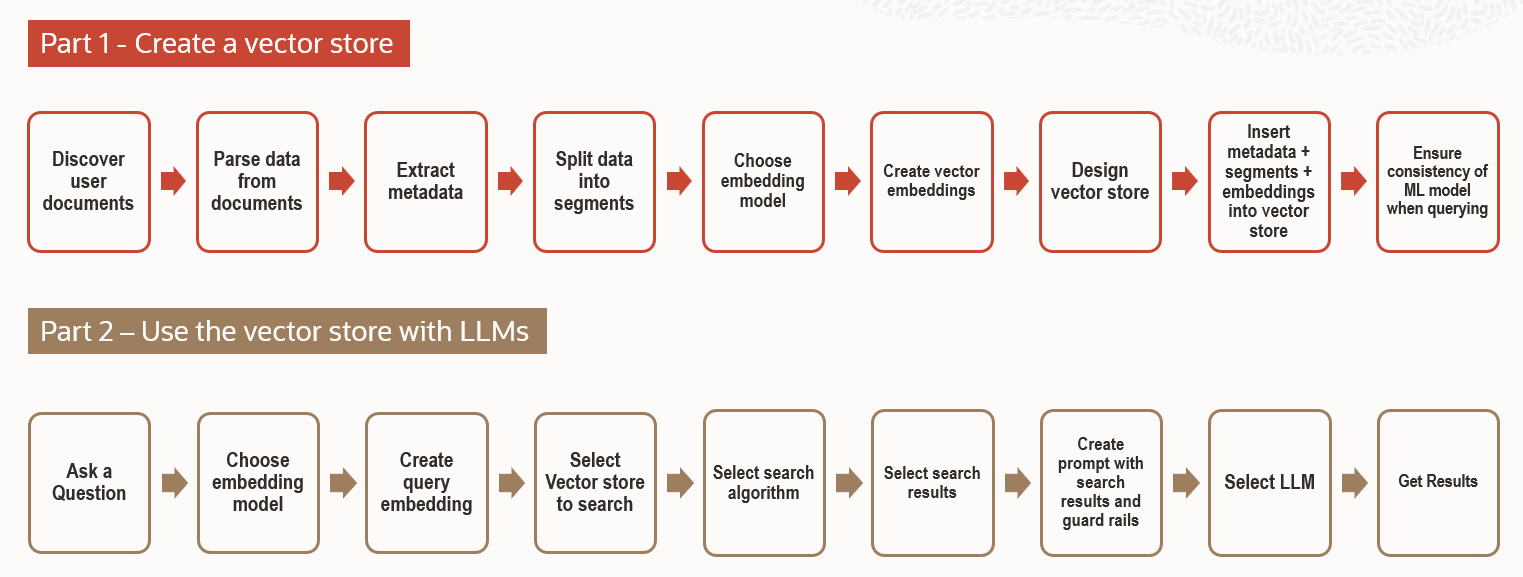In part 1 of our blog series, we reviewed how organizations can address the common challenges they face using MySQL-based databases by migrating to HeatWave MySQL. Part 2 of our “Succeed with HeatWave” blog series focuses on the second success pattern we can observe: Innovate with AI using HeatWave GenAI and HeatWave AutoML.
Common challenges when using Generative AI and ML, and how to help address them with HeatWave
Disparate AI services require integrations and AI expertise
While AI is top of mind for executives and developers alike, it can be complex to implement.
Customers typically need to integrate with external large language models (LLMs) and to move data to a separate vector database to use generative AI with their business data, i.e. to perform retrieval augmented generation (RAG). They may also need to use yet another external service for machine learning (ML). Using disparate services creates architectural complexity and delays the creation of business value. Security and regulatory compliance risks also increase as data moves between data stores/services, and so do costs.
Creating a vector store and using it with LLMs can involve about 20 steps requiring AI expertise:

With HeatWave GenAI, only 2 simple SQL statements are needed, making generative AI as simple as a database query.

HeatWave GenAI provides integrated, automated, and secure generative AI with in-database LLMs; an automated, in-database vector store; scale-out vector processing; and the ability to have contextual conversations in natural language—letting you take advantage of generative AI without AI expertise and data movement.
HeatWave GenAI helped SmarterD fast-track its roadmap by 12 months to launch SmarterD.ai, an enterprise AI platform. The company went from development to production in only one month, enabling generative AI use cases in its contract management and compliance management flows. In addition, SmarterD can deliver new modules supporting new use cases in only two to four weeks.
Similarly, HeatWave AutoML automates the ML lifecycle, including algorithm selection, intelligent data sampling for model training, feature selection, and hyperparameter optimization—helping data analysts and data scientists save significant time and effort. The interactive HeatWave AutoML console even lets business analysts build, train, run, and explain ML models using a visual interface—there’s no need to know SQL commands or coding.
Aicoll provides AI solutions for managing the risk of customers defaulting on loans. Using HeatWave AutoML, the company reduced the time to build ML models from three months to one week. They also accelerated data preparation from one day to minutes.
Disparate AI services increase costs
Using multiple services for generative AI and ML increases costs. Not only will you need to pay for several services instead of one, but also for integrations et data movements between them. Furthermore, multiple services typically require different skills, making staffing more complex.
Teyuto develops applications for organizations that want to create video platforms and monetize their products through on-demand or live streaming. By using HeatWave AutoML together with HeatWave MySQL for OLTP and analytics, Teyuto saved 35% in operational costs and increased staff productivity by 50%.
Similarly, Aiwifi provides Wi-Fi solutions that connect shoppers to shopping websites through customized captive portals and is using HeatWave AutoML to help its customers create more personalized marketing content. The company estimates that HeatWave replaced up to 5 external systems.
Provisioning GPUs for GenAI workloads may also be costly, and their availability tends to be scarce. Conversely, there are no additional costs to use the HeatWave GenAI in-database LLMs, and you can reduce infrastructure costs by eliminating the need to provision GPUs. Moreover, system resources are optimized (optimal configuration of thread count, batch size, and segment size) to further help reduce costs.
Finally, since HeatWave provides a unified solution, customers benefit from great synergies by combining generative AI with ML. In the below example, the application uses the HeatWave AutoML recommender system to suggest restaurants based on the user’s preferences or what the user previously ordered. With HeatWave Vector Store, the application can additionally search through restaurants’ menus in PDF format to help suggest specific dishes, providing greater value to customers.

Common use cases
HeatWave GenAI and HeatWave AutoML are implemented for applications such as:
- Detection of potential issues: production anomalies, loan default predictions, providing industry context for security vulnerabilities…etc.
- Personalized recommendations: products, marketing content, restaurants and dishes…etc.
- IT service management: classification, ticket assignment and resolution…etc.
- Chatbots: customer service, technical support, analytics assistant…etc.
- Contracts and compliance management: categorization, reviews, validations…etc.
- Content summarization and translation: eCommerce product reviews, university courses, restaurant menus…etc.
Conclusion
As discussed in the second part of our blog series, HeatWave can help you accelerate AI innovation. You can:
- Take advantage of generative AI without AI expertise, data movement, or additional cost.
- Benefit from great synergies by easily combining generative AI and machine learning within a single solution.
- Develop and deploy AI apps in your choice of cloud providers: HeatWave is available on OCI, AWS, and Microsoft Azure.
Don’t hesitate to contact us, we’ll be happy to discuss how we could help.
Resources
- Learn more about HeatWave GenAI
- AI Solution Hub
- Request a free workshop to evaluate or get started with HeatWave
